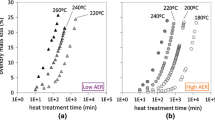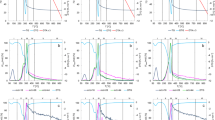Abstract
The temperature and gas concentrations in a newly established pine-wood debris pile of 20 m×15 m×6 m in dimensions (approximately 400 tons of fresh weight material) were monitored for 150 days. Temperature was measured at ten different positions within the pile, while concentrations of CO2, O2, CO and CH4 were taken at four different representative locations. The pile was characterized by a strong temperature increase within the first 10–12 days of storage. Results of the gas analysis in this period suggest that the temperature increase was caused by microbial processes. In particular, reduced oxygen concentration and almost complete absence of methane indicate mainly aerobic respiration processes. Effects of weather conditions on the temperature/gas distribution and time evolution are also discussed in the paper.
Zusammenfassung
Temperatur und Konzentration von CO2, O2, CO und CH4 wurden innerhalb einer neu aufgeschütteten Holzhalde mit einer Größe von 20 m×15 m×6 m (ca. 400 Tonnen des Frischgewichtes) über eine Lagerungsdauer von 150 Tagen gemessen. Die Temperatur wurde an zehn Positionen innerhalb der Halde aufgenommen, während die Gaskonzentrationen an vier repräsentativen Positionen nach Haldenaufbau gemessen wurden. Die Halde wies eine sehr starke Temperaturerhöhung in den ersten 10–12 Tagen der Lagerung auf. Die Ergebnisse der Gasanalysen während dieses Zeitraums sind indikativ dafür, dass mikrobielle Prozesse innerhalb der Halde die Haldenerwärmung verursacht haben. Insbesondere die geringe Sauerstoffkonzentration und die fast komplette Abwesenheit von Methan weisen auf eine hohe aerobe, mikrobielle Atmungsaktivität hin. Der Einfluss der Wetterlage auf die zeitliche Entwicklung und auf die Verteilung der Temperatur und der Gaskonzentrationen innerhalb der Halde werden in dieser Studie diskutiert.








Similar content being viewed by others
References
Bergman Ö, Nilsson T (1971) Studies on outside storage of sawmill chips. Research notes of the Department of Forest Products, Royal College of Forestry, Stockholm
CEN 14961:2005 Solid biofuels—fuel specification and classes, standard of the European Committee for Standardization (CEN)
Conrad R (1996) Soil microorganisms as controllers of atmospheric trace gases (H2, CO, CH4, OCS, N2O, and NO). Microbiol Rev 60:609–640
Ernstson ML, Rasmuson A (1993) Mathematical modelling of transport processes and degradation reactions in piles of forest fuel material. Fuel 72:1515–1524
Fengel D, Wegener G (1984) Wood chemistry, ultrastructure, reactions. Walter de Gruyter, Berlin
Ferrero F, Malow M, Berger A, Krause U (2007) Modelling the coupled heat and mass transfer during fires in stored biomass, coal and recycling deposits. In: Proceedings of the 1st European COMSOL conference, Grenoble, France, 23–24 October 2007
Hatakka A (1994) Lignin-modifying enzymes from selected white-rot fungi: production and role in lignin degradation. FEMS Microbiol Rev 13:125–135
Liang C, Das KC, McClendon RW (2003) The influence of temperature and moisture contents regimes on the aerobic microbial activity of a biosolids composting blend. Bioresour Technol 86:131–137
Nitsch J (2007) Ausbaustrategie Erneuerbare Energien, Aktualisierung und Neubewertung bis zu den Jahren 2020 und 2030 mit Ausblick bis 2050. Pilot study on behalf of the Federal Environment Ministry for the Environment, Nature Conservation and Nuclear Safety (in German)
Noll M, Naumann A, Ferrero F, Malow M (2010) Exothermic processes in industrial-scale piles of chipped pine-wood are linked to shifts in gamma-, alphaproteobacterial and fungal ascomycete communities. Int Biodet Biodeg 64:629–637
Scholz V, Idler C (2005) Energieverlust und Schimmelpilzentwicklung bei der Lagerung von Feldholz-Hackgut. Reports on Agro-Engineering, vol 39. Leibniz-Institut für Agrartechnik, Potsdam-Bornim (in German)
Acknowledgements
The authors would like to thank the German Federal Ministry of Education and Research for funding the project “Fire Prevention during Storage of Biomass Fuels” (FKZ: 01LS05079) within the scope of the research initiative “Klimazwei”. The authors take the responsibility of the contents of this publication.
Author information
Authors and Affiliations
Corresponding author
Rights and permissions
About this article
Cite this article
Ferrero, F., Malow, M. & Noll, M. Temperature and gas evolution during large scale outside storage of wood chips. Eur. J. Wood Prod. 69, 587–595 (2011). https://doi.org/10.1007/s00107-010-0512-0
Received:
Published:
Issue Date:
DOI: https://doi.org/10.1007/s00107-010-0512-0




